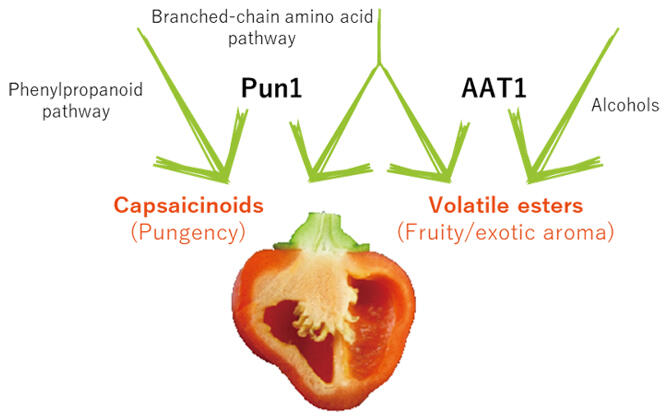A research group led by Associate Professor Sota Koeda, Tomona Noda (Graduate Student at the time of research) and Shinkai Hachisu (Graduate student at the time of this research) of the Graduate School of Agriculture at Kindai University has announced that they have identified the genes responsible for the fruity and exotic aromas of peppers through component, molecular biological and biochemical analyses of the fruits. It is expected that breeding for pepper fruit aroma will develop in the future. The results were published online in the August 30 issue of the international journal Plant Cell Reports.

Provided by Kindai University
There are two types of peppers: spicy varieties, which accumulate pungent capsaicinoids in their fruits, and non-spicy vegetable varieties (green peppers, bell peppers, etc.), which are unable to biosynthesize pungent compounds owing to genetic mutation. The genus Capsicum has five species, including C. annuum cultivars such as Cayenne, and C. chinense varieties such as Habanero, Scotch Bonnet and Bhut Jolokia. Researchers have hypothesized that volatile esters are the major contributors to the fruity and exotic aromas of the fruits of the C. chinense varieties.
Esters are biosynthesized through the condensation of various alcohols and acyl-CoA (a general term for compounds consisting of fatty acids and coenzyme A). Studies have reported that in tomato and other crops, alcohol acyltransferases (AATs) are involved in the biosynthesis of esters, whereas carboxylesterases (CXEs) play a role in their degradation, and the balance between the biosynthesis and degradation of esters determines their volatility. However, the mechanism of ester biosynthesis in peppers is not well understood. Furthermore, the precursor of esters, acyl-CoA, is also known to be a precursor of capsaicinoids.
The research group studied the aroma compounds volatilized by the fruits of several spicy species and found that the C. chinense varieties volatilized a large number of esters compared with the C. annuum varieties. Examination of the pepper DNA revealed seven AAT genes that may be involved in ester biosynthesis and one CXE gene that may play a role in ester degradation. When the expression levels of these genes were examined in fruits, only AAT1, AAT2 and CXE1 were expressed. Only AAT1 expression was higher in C. chinense and lower in C. annuum.
To clarify the relationship between AAT1 and ester biosynthesis, Escherichia coli was used to produce the pepper AAT1 protein. When the resulting protein was incubated with the substrates alcohol and acyl-CoA, ester biosynthesis was confirmed, as hypothesized. These results suggest that AAT1 is involved in the biosynthesis of the esters that contribute significantly to the fruity and exotic aromas of pepper fruits.
Koeda commented, "Based on the genetic knowledge we have gained, I expect that we will be able to make rational progress in breeding for aroma, which strongly influences consumer preferences."
Journal Information
Publication: Plant Cell Reports
Title: Expression of alcohol acyltransferase is a potential determinant of fruit volatile ester variations in Capsicum
DOI: 10.1007/s00299-023-03064-z
This article has been translated by JST with permission from The Science News Ltd. (https://sci-news.co.jp/). Unauthorized reproduction of the article and photographs is prohibited.




